Sapphire
| Sapphire | |
|---|---|
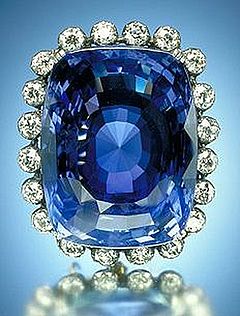
The 423-carat (85 g) blue Logan Sapphire
| |
| General | |
| Category | Oxide mineral |
| Formula (repeating unit) | Aluminium oxide, Al2O3 |
| Identification | |
| Color | Typically blue, but varies |
| Crystal habit | As crystals, massive and granular |
| Crystal system | Trigonal Symbol (32/m) Space Group: R3c |
| Fracture | Conchoidal, splintery |
| Mohs scalehardness | 9.0 |
| Luster | Vitreous |
| Specific gravity | 3.95–4.03 |
| Optical properties | Abbe number 72.2 |
| Refractive index | nω=1.768–1.772 nε=1.760–1.763, Birefringence 0.008 |
| Pleochroism | Strong |
| Melting point | 2,030–2,050 °C |
| Fusibility | Infusible |
| Solubility | Insoluble |
| Other characteristics |
Coefficient of thermal expansion (5.0–6.6)×10−6/K
relative permittivity at 20 °Cε = 8.9–11.1 (anisotropic) [1] |
Sapphire (Greek: σάπφειρος; sappheiros, 'blue stone',[2] which probably referred instead at the time to lapis lazuli) is a typically blue gemstone variety of the mineral corundum, an aluminium oxide (α-Al2O3). Trace amounts of elements such as iron, titanium, chromium, copper, or magnesium can give corundum respectively blue, yellow, purple, orange, or green color. Chromium impurities in corundum yield pink or red tint, the latter being called ruby.
Commonly, sapphires are worn in jewelry. Sapphires may be found naturally, by searching through certain sediments (due to their resistance to being eroded compared to softer stones) or rock formations. They also may be manufactured for industrial or decorative purposes in large crystal boules. Because of the remarkable hardness of sapphires – 9 on the Mohs scale (the third hardest mineral, after diamond at 10 and moissanite at 9.5) – and of aluminium oxide in general, sapphires are used in some non-ornamental applications, including infrared optical components, such as in scientific instruments; high-durability windows; wristwatch crystals and movement bearings; and very thin electronic wafers, which are used as the insulating substrates of very special-purpose solid-state electronics (especially integrated circuits and GaN-based LEDs).
Natural sapphires[edit]
The sapphire is one of the three gem-varieties of corundum, the other two being ruby (defined as corundum in a shade of red) and padparadscha (a pinkish orange variety). Although blue is their most well-known color, sapphires may also be colorless and they are found in many colors including shades of gray and black.
The cost of natural sapphires varies depending on their color, clarity, size, cut, and overall quality – as well as their geographic origin. Significant sapphire deposits are found in Eastern Australia, Thailand, Sri Lanka, China (Shandong), Madagascar, East Africa, and in North America in a few locations, mostly in Montana.[3] Sapphire and rubies are often found in the same geographic environment, but one of the gems is usually more abundant in any of the sites.[4]
Blue sapphire[edit]
Color in gemstones breaks down into three components: hue, saturation, and tone. Hue is most commonly understood as the "color" of the gemstone. Saturation refers to the vividness or brightness of the hue, and tone is the lightness to darkness of the hue.[5] Blue sapphire exists in various mixtures of its primary (blue) and secondary hues, various tonal levels (shades) and at various levels of saturation (vividness).
Blue sapphires are evaluated based upon the purity of their primary hue. Purple, violet, and green are the most common secondary hues found in blue sapphires.[6] Violet and purple can contribute to the overall beauty of the color, while green is considered to be distinctly negative. Blue sapphires with up to 15% violet or purple are generally said to be of fine quality. Blue sapphires with any amount of green as a secondary hue are not considered to be fine quality. Gray is the normal saturation modifier or mask found in blue sapphires. Gray reduces the saturation or brightness of the hue, and therefore has a distinctly negative effect.[6]
The color of fine blue sapphires may be described as a vivid medium dark violet to purplish blue where the primary blue hue is at least 85% and the secondary hue no more than 15%, without the least admixture of a green secondary hue or a gray mask.[5]
The 423-carat (84.6 g) Logan sapphire in the National Museum of Natural History, in Washington, D.C., is one of the largest faceted gem-quality blue sapphires in existence.
Sapphires of other colors[edit]
Yellow and green sapphires are also commonly found. Pink sapphires deepen in color as the quantity of chromium increases. The deeper the pink color the higher their monetary value, as long as the color is tending toward the red of rubies. In the United States, a minimum color saturation must be met to be called a ruby, otherwise the stone is referred to as a pink sapphire.[7]
Sapphires also occur in shades of orange and brown. Colorless sapphires are sometimes used as diamond substitutes in jewelry. Natural padparadscha (pinkish orange) sapphires often draw higher prices than many of even the finest blue sapphires. Recently, more sapphires of this color have appeared on the market as a result of a new artificial treatment method called "lattice diffusion".[8]
Padparadscha[edit]
Padparadscha is a delicate light to medium toned pink-orange to orange-pink hue corundum, originally found in Sri Lanka,[9] but also found in deposits in Vietnam and parts of East Africa. Padparadscha sapphires are rare; the rarest of all is the totally natural variety, with no sign of artificial treatment.[10]
The name is derived from the Sanskrit "padma ranga" (padma = lotus; ranga = color), a color akin to the lotus flower (Nelumbo nucifera ‘Speciosa’).[11]
Star sapphire[edit]
A star sapphire is a type of sapphire that exhibits a star-like phenomenon known as asterism; red stones are known as "star rubies". Star sapphires contain intersecting needle-like inclusions following the underlying crystal structure that causes the appearance of a six-rayed "star"-shaped pattern when viewed with a single overhead light source. The inclusion is often the mineral rutile, a mineral composed primarily of titanium dioxide.[12] The stones are cuten cabochon, typically with the center of the star near the top of the dome. Occasionally, twelve-rayed stars are found, typically because two different sets of inclusions are found within the same stone, such as a combination of fine needles of rutile with small platelets of hematite; the first results in a whitish star and the second results in a golden-colored star. During crystallisation, the two types of inclusions become preferentially oriented in different directions within the crystal, thereby forming two six-rayed stars that are superimposed upon each other to form a twelve-rayed star.[13] Misshapen stars or 12-rayed stars may also form as a result of twinning. The inclusions can alternatively produce a "cat's eye" effect[14] if the 'face-up' direction of the cabochon's dome is oriented perpendicular to the crystal's c-axis rather than parallel to it. If the dome is oriented in between these two directions, an 'off-center' star will be visible, offset away from the high point of the dome.[10]
The Black Star of Queensland, the largest gem-quality star sapphire in the world, weighs 733 carats.[15] The Star of India (mined in Sri Lanka) (weighing 563.4 carats) is thought to be the second-largest star sapphire (the largest blue), and is currently on display at the American Museum of Natural History in New York City. The 182-carat Star of Bombay, (mined in Sri Lanka), located in the National Museum of Natural History, in Washington, D.C., is another example of a large blue star sapphire. The value of a star sapphire depends not only on the weight of the stone, but also the body color, visibility, and intensity of the asterism.[citation needed]
Color change sapphire[edit]
A rare variety of natural sapphire, known as color-change sapphire, exhibits different colors in different light. Color change sapphires are blue in outdoor light and purple under incandescent indoor light, or green to gray-green in daylight and pink to reddish-violet in incandescent light. Color change sapphires come from a variety of locations, including Thailand and Tanzania. The color-change effect is caused by the interaction of the sapphire, which absorbs specific wavelengths of light, and the light-source, whose spectral output varies depending upon the illuminant. Transition-metal impurities in the sapphire, such as chromium and vanadium, are responsible for the color change.[16]
Certain synthetic color-change sapphires have a similar color change to the natural gemstone alexandrite and they are sometimes marketed as "alexandrium" or "synthetic alexandrite". However, the latter term is a misnomer: synthetic color-change sapphires are, technically, not synthetic alexandrites but rather alexandrite simulants. This is because genuine alexandrite is a variety of chrysoberyl: not sapphire, but an entirely different mineral.[17]
Source of color[edit]
Rubies are corundum which contain chromium impurities that absorb yellow-green light and result in deeper ruby red color with increasing content.[18] Purple sapphires contain trace amounts of vanadium and come in a variety of shades. Corundum that contains ~0.01% of titanium is colorless. If trace amounts of iron are present, a very pale yellow to green color may be seen. However, if both titanium and iron impurities are present together, and in the correct valence states, the result is a deep-blue color.[19]
Unlike localized ("intra-atomic") absorption of light which causes color for chromium and vanadium impurities, blue color in sapphires comes from intervalence charge transfer, which is the transfer of an electron from one transition-metal ion to another via the conduction or valence band. The iron can take the form Fe2+ or Fe3+, while titanium generally takes the form Ti4+. If Fe2+ and Ti4+ ions are substituted for Al3+, localized areas of charge imbalance are created. An electron transfer from Fe2+ and Ti4+ can cause a change in the valence state of both. Because of the valence change there is a specific change in energy for the electron, and electromagnetic energy is absorbed. The wavelength of the energy absorbed corresponds to yellow light. When this light is subtracted from incident white light, the complementary color blue results. Sometimes when atomic spacing is different in different directions there is resulting blue-green dichroism.
Intervalence charge transfer is a process that produces a strong colored appearance at a low percentage of impurity. While at least 1% chromium must be present in corundum before the deep red ruby color is seen, sapphire blue is apparent with the presence of only 0.01% of titanium and iron.
Treatments[edit]
Sapphires may be treated by several methods to enhance and improve their clarity and color.[20] It is common practice to heat natural sapphires to improve or enhance color. This is done by heating the sapphires in furnaces to temperatures between 500 and 1,800 °C (932 and 3,272 °F) for several hours, or by heating in a nitrogen-deficient atmosphere oven for seven days or more. Upon heating, the stone becomes more blue in color, but loses some of the rutile inclusions (silk). When high temperatures are used, the stone loses all silk (inclusions) and it becomes clear under magnification.[21] The inclusions in natural stones are easily seen with a jeweler's loupe. Evidence of sapphire and other gemstones being subjected to heating goes back at least to Roman times.[22] Un-heated natural stones are somewhat rare and will often be sold accompanied by a certificate from an independent gemological laboratory attesting to "no evidence of heat treatment".
Yogo sapphires sometimes do not need heat treating because their cornflower blue coloring is uniform and deep, they are generally free of the characteristic inclusions, and they have high uniform clarity.[23] When Intergem Limited began marketing the Yogo in the 1980s as the world's only guaranteed untreated sapphire, heat treatment was not commonly disclosed; by 1982 the heat treatment became a major issue.[24] At that time, 95% of all the world's sapphires were being heated to enhance their natural color.[25] Intergem's marketing of guaranteed untreated Yogos set them against many in the gem industry. This issue appeared as a front page story in the Wall Street Journal on 29 August 1984 in an article by Bill Richards, Carats and Schticks: Sapphire Marketer Upsets The Gem Industry.[25]
Diffusion treatments are used to add impurities to the sapphire to enhance color. Typically beryllium is diffused into a sapphire under very high heat, just below the melting point of the sapphire. Initially (c. 2000) orange sapphires were created, although now the process has been advanced and many colors of sapphire are often treated with beryllium. The colored layer can be removed when stones chip or are repolished or refaceted, depending on the depth of the impurity layer. Treated padparadschas may be very difficult to detect, and many stones are certified by gemological labs (e.g., Gubelin, SSEF, AGTA).
According to United States Federal Trade Commission guidelines, disclosure is required of any mode of enhancement that has a significant effect on the gem's value.[26]
There are several ways of treating sapphire. Heat-treatment in a reducing or oxidising atmosphere (but without the use of any other added impurities) is commonly used to improve the color of sapphires, and this process is sometimes known as "heating only" in the gem trade. In contrast, however, heat treatment combined with the deliberate addition of certain specific impurities (e.g. beryllium, titanium, iron, chromium or nickel, which are absorbed into the crystal structure of the sapphire) is also commonly performed, and this process can be known as "diffusion" in the gem trade. However, despite what the terms "heating only" and "diffusion" might suggest, both of these categories of treatment actually involve diffusion processes.[27]
Mining[edit]
Sapphires are mined from alluvial deposits or from primary underground workings. Commercial mining locations for sapphire and ruby include (but are not limited to) the following countries: Afghanistan, Australia, Myanmar/Burma,Cambodia, China, Colombia, India, Kenya, Laos, Madagascar, Malawi, Nepal, Nigeria, Pakistan, Sri Lanka, Tajikistan, Tanzania, Thailand, USA, and Vietnam. Sapphires from different geographic locations may have different appearances or chemical-impurity concentrations, and tend to contain different types of microscopic inclusions. Because of this, sapphires can be divided into three broad categories: classic metamorphic, non-classic metamorphic or magmatic, and classic magmatic.[28]
Sapphires from certain locations, or of certain categories, may be more commercially appealing than others,[29] particularly classic metamorphic sapphires from Kashmir (India), Burma, or Sri Lanka that have not been subjected to heat-treatment.[30][31][32]
The Logan sapphire, the Star of India, and the Star of Bombay originate from Sri Lankan mines. Madagascar is the world leader in sapphire production (as of 2007) specifically its deposits in and around the town of Ilakaka.[33] Prior to the opening of the Ilakaka mines, Australia was the largest producer of sapphires (such as in 1987).[34] In 1991 a new source of sapphires was discovered in Andranondambo, southern Madagascar. That area has been exploited for its sapphires started in 1993, but it was practically abandoned just a few years later—because of the difficulties in recovering sapphires in their bedrock.[35]
In North America, sapphires have been mined mostly from deposits in Montana: fancies along the Missouri River near Helena, Montana, Dry Cottonwood Creek near Missoula, Montana, and Rock Creek near Philipsburg, Montana. Fine blue Yogo sapphires are found at Yogo Gulch west of Lewistown, Montana.[36] A few gem-grade sapphires and rubies have also been found in the area of Franklin, North Carolina.[37]
The sapphire deposits of Kashmir are still well known in the gem industry,[38] despite the fact that the peak production from this area mostly took place in a relatively short period at the end of the nineteenth and early twentieth centuries.[39] Kashmir-origin contributes meaningfully to the value of a sapphire, and most corundum of Kashmir origin can be readily identified by its characteristic silky appearance and exceptional hue.[40] At present, the world record price-per-carat for sapphire at auction was achieved by a sapphire from Kashmir in a ring, which sold for approximately $212,000 per carat (more than $7.45 million in total, including buyer's premium) in May 2015.[41]
Synthetic sapphire[edit]
In 1902 the French chemist Auguste Verneuil developed a process for producing synthetic sapphire crystals.[42] In the Verneuil process, named after him, fine alumina powder is added to an oxyhydrogen flame, and this is directed downward against a mantle.[43] The alumina in the flame is slowly deposited, creating a teardrop shaped "boule" of sapphire material. Chemical dopants can be added to create artificial versions of the ruby, and all the other natural colors of sapphire, and in addition, other colors never seen in geological samples. Artificial sapphire material is identical to natural sapphire, except it can be made without the flaws that are found in natural stones. The disadvantage of Verneuil process is that the grown crystals have high internal strains. Many methods of manufacturing sapphire today are variations of the Czochralski process, which was invented in 1916 by Polish chemist Jan Czochralski.[44] In this process a tiny sapphire seed crystal is dipped into a crucible made of the precious metal iridium or molybdenum,[45] containing molten alumina, and then slowly withdrawn upward at a rate of 1 to 100 mm per hour. The alumina crystallizes on the end, creating long carrot-shaped boules of large size up to 200 kg in mass.[46]
Synthetic sapphire is also produced industrially from agglomerated aluminium oxide, sintered and fused (such as by hot isostatic pressing) in an inert atmosphere, yielding a transparent but slightly porous polycrystallineproduct.[citation needed]
In 2003 the world's production of synthetic sapphire was 250 tons (1.25 × 109 carats), mostly by the United States and Russia.[47][48] The availability of cheap synthetic sapphire unlocked many industrial uses for this unique material:
The first laser was made with a rod of synthetic ruby. Titanium-sapphire lasers are popular due to their relatively rare capacity to be tuned to various wavelengths in the red and near-infrared region of the electromagnetic spectrum. They can also be easily mode-locked. In these lasers a synthetically produced sapphire crystal with chromium or titanium impurities is irradiated with intense light from a special lamp, or another laser, to create stimulated emission.
High quality synthetic sapphire substrates use in nanotechnology is often called Blue Glass, due to its blue color.
Common applications[edit]
Along with zirconia and aluminium oxynitride, synthetic sapphire is used for shatter resistant windows in armored vehicles and various military body armor suits, in association with composites.
One type of xenon arc lamp (originally called the "Cermax" its first brand name), which is now known generically as the "ceramic body xenon lamp", uses sapphire crystal output windows that tolerate higher thermal loads – and thus higher output powers when compared with conventional Xe lamps with pure silica window.[49]
Sapphire glass[edit]
One application of synthetic sapphire is sapphire glass often called blue glass as sapphires are blue in color. Here glass is a layman term which refers not to the amorphous state, but to the transparency. Sapphire is not only highly transparent to wavelengths of light between 150 nm (UV) and 5500 nm (IR) (the human eye can discern wavelengths from about 380 nm to 750 nm[50]), but is also extraordinarily scratch-resistant. Sapphire has a value of 9 on the Mohs scale of mineral hardness.
The key benefits of sapphire windows are:
- Very wide optical transmission band from UV to near-infrared, (0.15-5.5 µm)
- Significantly stronger than other optical materials or standard glass windows
- Highly resistant to scratching and abrasion (9 Mohs scale, the 3rd hardest natural substance next to moissanite and diamonds)
- Extremely high melting temperature (2030 °C)
So-called "sapphire glass" refers to crystalline sapphire used as an optical window or cover.[51][52] Some windows are made from pure sapphire boules that have been grown in a specific crystal orientation, typically along the optical axis, the c-axis, for minimumbirefringence for the application. The boules are sliced up into the desired window thickness and finally polished to the desired surface finish. Sapphire optical windows can be polished to a wide range of surface finishes due to its crystal structure and its hardness. The surface finishes of optical windows are normally called out by the scratch-dig specifications in accordance with the globally adopted MIL-O-13830 specification.
Sapphire windows are used in Apple Touch ID of the iPhone 5s, iPhone 6, and iPad mini 3[53][54][55] and the display of the Apple Watch.[56] Also, sapphire covers are used for the rear camera in every iPhone 5[57] or newer.
The Sapphire windows are used in high pressure chambers for spectroscopy, crystals in various watches, and windows in grocery store barcode scanners since the material's exceptional hardness and toughness makes it very resistant to scratching.[47]
It is used for end windows on some high-powered laser tubes as its wide-band transparency and thermal conductivity allow it to handle very high power densities in the infra-red or UV spectrum without degrading due to heating.
Use as substrate for semiconducting circuits[edit]
Main article: silicon on sapphire
Thin sapphire wafers were the first successful use of an insulating substrate upon which to deposit silicon to make the integrated circuits known as silicon on sapphire or "SOS"; now other substrates can also be used for the class of circuits known more generally as silicon on insulator. Besides its excellent electrical insulating properties, sapphire has high thermal conductivity. CMOS chips on sapphire are especially useful for high-power radio-frequency (RF) applications such as those found in cellular telephones, public-safety band radios, and satellite communication systems. "SOS" also allows for the monolithic integration of both digital and analog circuitry all on one IC chip, and the construction of extremely low power circuits.
In one process, after single crystal sapphire boules are grown, they are core-drilled into cylindrical rods, and wafers are then sliced from these cores.[citation needed]
Wafers of single-crystal sapphire are also used in the semiconductor industry as a substrate for the growth of devices based on gallium nitride (GaN). The use of sapphire significantly reduces the cost, because it has about one-seventh the cost of germanium. Gallium nitride on sapphire is commonly used in blue light-emitting diodes (LEDs).[58]
Use for endoprostheses[edit]
Monocrystalline sapphire is fairly biocompatible and the exceptionally low wear of sapphire–metal pairs have led to the successful introduction (in the Ukraine) of sapphire monocrystals for hip joint endoprostheses.[59] Thousands of patients have received these endoprostheses. The low wear significantly prolongs the usable life of the endoprostheses, making the use of the intrinsically expensive monocrystal sapphire cost-effective.

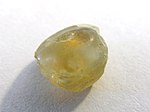


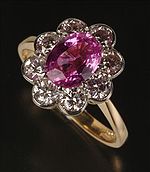

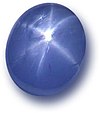




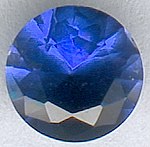





Nenhum comentário:
Postar um comentário